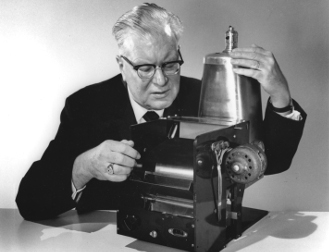Are We Missing Our Xerox Moment?
NEW YORK—I recently attended a meeting, held in a conference room dedicated to Chester Floyd Carlson. It’s unlikely that you ever heard of him, but he changed your life. His invention is perhaps third behind only the printing press and the Internet in its revolutionary impact on communication.

Chester Floyd Carlson with an early prototype of his Xerox machine. (Photo credit: Xerox Historical Archives)
Carlson was the inventor of the dry photocopy process, which led directly to the development of the Xerox machine. Like so many others, his invention was driven by personal need. An inventor turned patent office attorney, Carlson was burdened by the difficulty involved in using carbon paper to make the many manual copies that the patent office required.
Carlson patented his process, but it took 10 years before the world woke up. No one could think beyond the carbon paper approach—after all, why would an electronic device that only made one copy at a time be needed? Besides, when multiple copies were needed the tried and true wet mimeograph process was already available.
Between 1939 and 1944, Carlson was turned down by more than 20 major entities including behemoths like IBM, GE, Eastman-Kodak, and the Navy. It wasn’t until 1946 that the owners of Haloid Photographic Company saw its potential and 1949 when the term “Xerox” was created and the invention finally began to be commercialized. Eventually, Chester Floyd Carlson became one of the richest men in America.
RIGHT UNDER OUR NOSES?
The key point here is that the world took 10 years to recognize that photocopying could be valuable to investors and 20 years to make it commercially useful. As I stared at Carlson’s name I wondered—what are the Xerox machines of today? More specifically, what opportunities are right under the noses of broadcasters and other media people that would change the world if seen properly.
I had one sitting in my pocket.
The mobile smartphone has already changed the world, and it is changing our industry, by disentangling consumers from their TVs and cable boxes. But rarely do we talk about how this device might be used to change the way television is created—how content is brought in. Most are just tipping their toes into the transformative value this device could have.
I think we need to open our eyes a bit wider. This is a challenging time. Ours is a world of fragmented marketplaces. New media companies struggle to make a dollar on the internet, while old media companies are squeezed between lower viewership, older demographics, higher production costs and cord-cutters dropping their cable subscriptions.
Consider just one scenario: news gathering. A typical remote from a foreign land is created by harnessing a camera crew, satellite uplink, hundreds of dollars of satellite time, plus a transmission engineer to book and check the feed. The results are usually a one-way signal with significant latency. Cellular bonding solutions are relatively less expensive and more mobile than satellite, but are still quite costly, do not support real-time return video, and extensive encoding delays cause the reporter to nod while the anchor’s question is being asked. I dare you to try having a back-and-forth conversation between a reporter and a studio using either of these choices.
SMARTPHONES THE KEY TO BROADCAST’S FUTURE?
There are already 2.5 billion smartphones in the world powered by more than 1.5 billion 4G LTE connections—and that is expected to rise to half of all people on the planet by the early 2020s. A smartphone can make a video call without downloading an application with very small latency, from anywhere on the planet, virtually for free. Best of all, there is an immediate, real-time return video channel.
Sure, some will say that the video quality of these services can vary and when you first try them, the connections can sometimes be iffy. I say, so what? The same can be said of the original video tape machine and dozens of other technologies that were adopted by news at early stages. There are ways to improve the reliability and such benefits are already achievable with only a small drop in image quality.
Moreover, with billions of users, the scale of development is immense. Does anyone doubt that the reliability will improve? What if instead of three live feeds in a newscast, one could have 40, or 1,000? That’s contribution on an unprecedented, almost unimagined scale. Mobile’s pervasiveness, low latency, return video, and vanishingly low cost could be used to create an entirely new type of program.
Penetration of smartphones for the highly desirable demographic 18-34 year olds is at 92 percent. This generation likes to see themselves as part of the conversation (I call them the “selfie generation”). Perhaps a new type of program using their live video would socially engage the audience and make them active participants through their smartphones.
Investing time today in exploring the new boundaries of newsgathering, social interaction and new programs enabled by this new form of communication could help engage and focus an audience, provide a lead or differentiation over a competitor, improve workflows, enhance productivity and reduce costs. Better yet, those who step up now get to help define how the technology will be used for the industry to follow.
There are smartphones today with 4K cameras. 5G will arrive in a few years. At some point everyone will be making television like this. Why wait? Are you willing to miss the next Xerox machine?
Ask yourself, “What would Chester Floyd Carlson say?”
Larry Thaler is the President of Positive Flux, a consulting firm that specializes in helping media companies take advantage of the rapid changes occurring in the industry.He can be reached via TV Technology.
Get the TV Tech Newsletter
The professional video industry's #1 source for news, trends and product and tech information. Sign up below.
